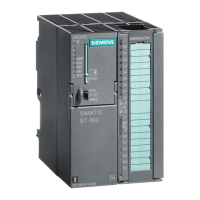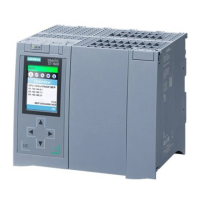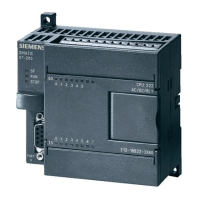&RQILJXULQJ
S7-300 Automation System, Hardware and Installation: CPU 312IFM - 318-2 DP
5-36 A5E00203919-01
'LIIHUHQFHVLQWKHFDVHRI03,DGGUHVVHVRI&3V)0VLQDQ6
Table 5-15 MPI addresses of CPs/FMs in an S7-300
2SWLRQV ([DPSOH
Example:
An S7-300 CPU and 2 CPs in one unit.
You have two options for assigning MPI
addresses of CPs/FMs installed in one
unit:
CP
SF
BUSF
DC5V
FRCE
RUN
STOP
CP
CPU
SM
)LUVWRSWLRQThe CPU adopts the CP
MPI addresses you specify in STEP 7.
MPI address MPI
address
+x
MPI
address
.+y
6HFRQGRSWLRQThe CPU automatically
determines the MPI addresses of the CPs
in their configuration as follows: MPI
address of CPU; MPI address +1; MPI
address +2.
(Default)
MPI address MPI
address
+1
MPI
address
+2
6SHFLDOIHDWXUHV&38'3 This CPU uses only one MPI address,
including the CPs connected.
5HFRPPHQGDWLRQVIRUWKH03,DGGUHVVQ
Reserve MPI address “0“ for a service PG or “1“ for a service OP. You can later
connect them temporarily to the subnet. Also, assign other MPI addresses to
PGs/OPs operating on the MPI subnet.
Recommended MPI address for the CPU in case of replacement or service:
Reserve MPI address “2” for the CPU. This prevents duplication of MPI addresses
after you connect a CPU with default settings to the MPI subnet (for example,
when replacing a CPU). That is, you must assign an MPI address greater than “2”
to CPUs on the MPI subnet.
5HFRPPHQGHG03,DGGUHVVQ
Reserve PROFIBUS address “0” for a service PG that you can subsequently
connect briefly to the PROFIBUS subnet if required. Therefore, assign unique
PROFIBUS addresses to PGs integrated in the PROFIBUS subnet.

